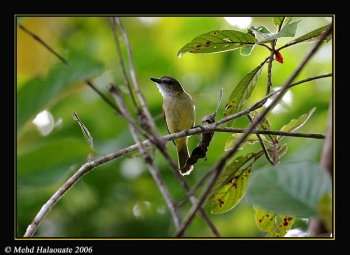Alternative name: Brown Whistler; Brown Thickhead (simplex); York Thickhead (peninsulae)
- Pachycephala simplex
Includes Grey-headed Whistler
Identification
14 - 15cm
P. s. simplex:
- Grey-brown upperparts, pale buff eyebrow, pale grey-buff band across faintly streaked upper breast, white to buff-white underparts
P. s. peninsulae:
- Grey head, an olive back, olive-buff upper breast merging with pale yellow lower breast
New Guinea subspecies:
- Grey head, olive-green upperparts and tail, white chin and throat, grey streaked in some subspecies (eg sudestensis), pale yellow underparts, some subspecies with a darker (olive-buff to brownish) upperbreast
Sexes alike. Juveniles have rufous-brown upperparts.
Distribution
Northern Australia and New Guinea.
Taxonomy
The New Guinea and other island subspecies are split by some authorities as "Grey-headed Whistler", P. griseiceps.
Subspecies
Clements recognises the following subspecies [1]:
- P. g. rufipennis: Kai Islands (Kai Kecil and Kai Besar)
- P. g. miosnomensis: Meos Num Island (New Guinea)
- P. g. griseiceps: New Guinea: northwestern Islands, Aru Islands, Bird's Head and Bird's Neck to southern lowlands, Trans-Fly, and southern Southeastern Peninsula east to Port Moresby
- P. g. jobiensis: Northern New Guinea and Yapen Island
- P. g. brunnescens: South-eastern New Guinea and D'Entrecasteaux Archipelago
- P. g. sudestensis: Tagula Island (Louisiade Archipelago)
- P. g. peninsulae: North-eastern Queensland south to Rockingham Bay; Hinchinbrook Island
- P. s. simplex: Northern part of Northern Territory, Australia
Habitat
Rainforest, monsoon forest, mangroves and tall secondary growth. Occurs from sea-level to 1400 m in New Guinea.
Behaviour
Diet
Feeds mainly on insects but takes also spiders and some seeds.
Forages in the middle and upper storey of the forest.
Breeding
Breeding season from December to March for simplex and October to January for peninsulae. In New Guinea, breeding recorded at the end of the wet season and beginning of dry season. The nest is a cup made of grass, leaves, rootlets, twigs and plant fibre. It's placed in a tree fork some 6 - 15m above the ground. Lays 2 eggs.
Movements
Resident species.
References
- Clements, J. F., T. S. Schulenberg, M. J. Iliff, D. Roberson, T. A. Fredericks, B. L. Sullivan, and C. L. Wood. 2017. The eBird/Clements checklist of birds of the world: v2017, with updates to August 2017. Downloaded from http://www.birds.cornell.edu/clementschecklist/download/
- Simpson, K and N Day. 1998. Field Guide to the Birds of Australia. London: Christopher Helm. ISBN 0-7136-4877-5
- Del Hoyo, J, A Elliott, and D Christie, eds. 2007. Handbook of the Birds of the World. Volume 12: Picathartes to Tits and Chickadees. Barcelona: Lynx Edicions. ISBN 978-8496553422
Recommended Citation
- BirdForum Opus contributors. (2024) Grey Whistler. In: BirdForum, the forum for wild birds and birding. Retrieved 20 April 2024 from https://www.birdforum.net/opus/Grey_Whistler





